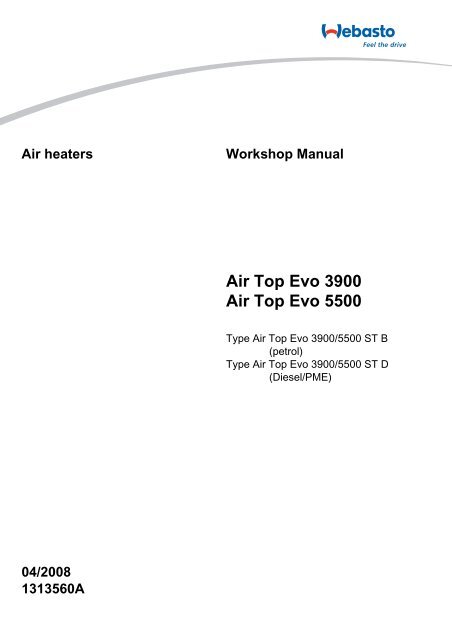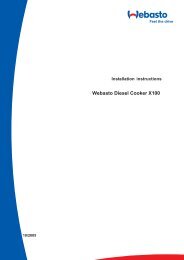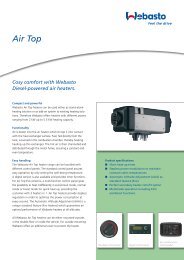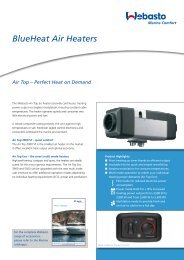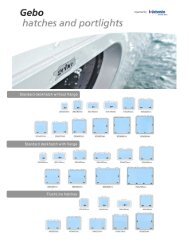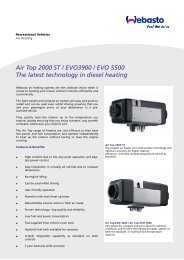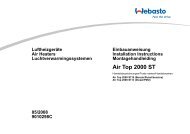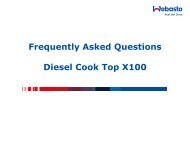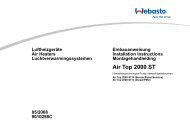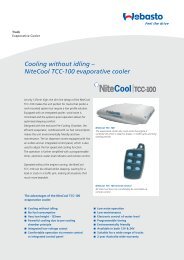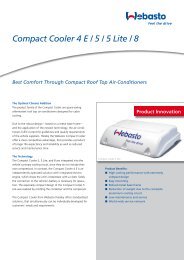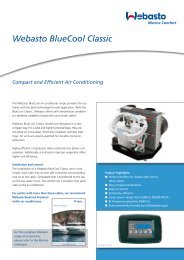AirTop Evo Workshop Manual (PDF, 3,37 MB) - Webasto
AirTop Evo Workshop Manual (PDF, 3,37 MB) - Webasto
AirTop Evo Workshop Manual (PDF, 3,37 MB) - Webasto
- No tags were found...
You also want an ePaper? Increase the reach of your titles
YUMPU automatically turns print PDFs into web optimized ePapers that Google loves.
Air heaters03/2003Air heaters<strong>Workshop</strong> <strong>Manual</strong>Air Top <strong>Evo</strong> 3900Air Top <strong>Evo</strong> 5500Type Air Top <strong>Evo</strong> 3900/5500 ST B(petrol)Type Air Top <strong>Evo</strong> 3900/5500 ST D(Diesel/PME)04/20081313560A
Air Top <strong>Evo</strong> 3900/5500Improper installation or repair of <strong>Webasto</strong> heating and cooling systems cancause fire or the leakage of deadly carbon monoxide leading to serious injury ordeath.To install and repair <strong>Webasto</strong> heating and cooling systems you need to havecompleted a <strong>Webasto</strong> training course and have the appropriate technicaldocumentation, special tools and special equipment.NEVER try to install or repair <strong>Webasto</strong> heating or cooling systems if you have notcompleted a <strong>Webasto</strong> training course, you do not have the necessary technicalskills and you do not have the technical documentation, tools and equipmentavailable to ensure that you can complete the installation and repair workproperly.ALWAYS carefully follow <strong>Webasto</strong> installation and repair instructions and heedall WARNINGS.<strong>Webasto</strong> rejects any liability for problems and damage caused by the systembeing installed by untrained personnel.
Air Top <strong>Evo</strong> 3900/5500Table of ContentsTable of Contents1 Introduction1.1 Contents and purpose ........................................................................................................................... 1011.1.1 Use of the air heaters .................................................................................................................. 1011.2 Meaning of signal words ........................................................................................................................ 1011.3 Additional documentation to be used..................................................................................................... 1011.4 Statutory regulations and safety instructions ......................................................................................... 1011.4.1 Statutory regulations governing installation................................................................................. 1011.4.2 General safety information .......................................................................................................... 1022 General description2.1 Drive unit................................................................................................................................................ 2022.2 Heat exchanger ..................................................................................................................................... 2022.3 Burner insert with combustion pipe........................................................................................................ 2022.4 Control unit ............................................................................................................................................ 2032.5 Glow plug / Flame monitor..................................................................................................................... 2032.6 Overheating sensor ............................................................................................................................... 2032.7 Metering pump....................................................................................................................................... 2033 Function description3.1 Control element ..................................................................................................................................... 3013.2 Switch on ............................................................................................................................................... 3013.3 Heating mode ........................................................................................................................................ 3013.4 Control mode ......................................................................................................................................... 3013.5 Control pause ........................................................................................................................................ 3023.6 Switch off ............................................................................................................................................... 3023.7 Heater functions when installed in ADR vehicles .................................................................................. 3023.7.1 Extract from Directive 2001/56/EC Annex IX...................................................................... 3023.8 Fault lock-out ......................................................................................................................................... 3033.8.1 Error monitor................................................................................................................................ 3033.8.2 Reset a fault lock-out................................................................................................................... 3044 Technical data ................................................................................................................................................ 401I
Table of Contents Air Top <strong>Evo</strong> 3900/55005 Troubleshooting5.1 General ................................................................................................................................................. 5015.2 General error symptoms ....................................................................................................................... 5015.3 Error symptoms during function............................................................................................................ 5025.4 Error code output .................................................................................................................................. 5036 Function tests6.1 General ................................................................................................................................................. 6016.2 Settings................................................................................................................................................. 6016.2.1 Setting the CO 2 content.............................................................................................................. 6016.3 Testing individual components.............................................................................................................. 6016.3.1 Glow plug resistance text............................................................................................................ 6016.3.2 Overheating sensor resistance test ............................................................................................ 6017 Circuit diagrams7.1 General ................................................................................................................................................. 7017.2 Legend for circuit diagrams................................................................................................................... 7068 Servicing work8.1 General ................................................................................................................................................. 8018.2 Work on the heater ............................................................................................................................... 8018.3 Work on the vehicle .............................................................................................................................. 8018.4 Heater trial ............................................................................................................................................ 8018.5 Servicing work....................................................................................................................................... 8018.6 Visual inspections and installation instructions..................................................................................... 8018.6.1 Hot air system............................................................................................................................. 8018.6.2 Fuel supply ................................................................................................................................. 8028.6.3 Metering pump............................................................................................................................ 8058.6.4 Fuel filter..................................................................................................................................... 8058.6.5 Combustion air supply ................................................................................................................ 8068.6.6 Exhaust pipe............................................................................................................................... 8068.6.7 Combustion air inlet and exhaust lines....................................................................................... 8068.6.8 Electrical connections................................................................................................................. 8078.7 Removal and installation....................................................................................................................... 8098.7.1 Heater, removal and installation ................................................................................................. 8098.8 Start-up ................................................................................................................................................. 809II
Air Top <strong>Evo</strong> 3900/5500Table of Contents9 Repair9.1 General .................................................................................................................................................. 9019.1.1 Work on stripped down components ........................................................................................... 9019.1.2 Carrying out modifications ........................................................................................................... 9019.2 Dismantling and assembling.................................................................................................................. 9029.2.1 Remove the casing parts............................................................................................................. 9029.2.2 Fit the casing parts ...................................................................................................................... 9029.2.3 Change the control unit ............................................................................................................... 9049.2.4 Change the overheating sensor .................................................................................................. 9049.2.5 Change the combustion and hot air blower (drive unit) ............................................................... 9049.2.6 Change the burner and the glow plug/flame sensor.................................................................... 9069.2.7 Change the combustion pipe and the heat exchanger................................................................ 90610 Packaging, storage and shipping10.1 General ................................................................................................................................................ 1001III
List of illustrations Air Top <strong>Evo</strong> 3900/5500List of illustrations501 General error symptoms ............................................................................................................................ 501502 Error symptoms during function ................................................................................................................. 502503 Troubleshooting ......................................................................................................................................... 50<strong>37</strong>01 Plug assignment ........................................................................................................................................ 701702 System circuit diagram 12V/24V with control element and vehicle blower ................................................ 702703 System circuit diagram 24V ADR operation with control element.............................................................. 702704 System circuit diagram 12V/24V with combination timer and vehicle blower ............................................ 70<strong>37</strong>05 System circuit diagram (diesel) 12V/24V with combination timer and electrical battery isolation switch... 70<strong>37</strong>06 System circuit diagram (diesel) 12V/24V with Control Panel MC04/05 and vehicle blower ...................... 704707 System circuit diagram (diesel) 24V ADR-operation with Control Panel MC04/05.................................... 704708 Schematic connection of the combination timer ........................................................................................ 705709 Schematic connection of the Control Panel MC04/05 ............................................................................... 705801 Fuel supply................................................................................................................................................. 803802 <strong>Webasto</strong> fuel extractor ............................................................................................................................... 804803 Fuel extractor from the plastic tank (extraction through tank drain screw) ................................................ 804804 Fuel extractor from the plastic tank (pickup via tank fitting) ....................................................................... 804805 Pipe/Hose connections .............................................................................................................................. 805806 Metering pump, installation position........................................................................................................... 805807 Fuel filter .................................................................................................................................................... 805808 Exhaust silencer......................................................................................................................................... 806809 Exhaust pipe mouth, installation position................................................................................................... 806810 Remove the fastening plate on the fuse holder ......................................................................................... 807811 Fuse holder, installation position................................................................................................................ 807812 Control element.......................................................................................................................................... 807813 Disconnect the plug ................................................................................................................................... 807814 Specimen installation for heater in an air circulation system ..................................................................... 808901 Remove / fit the casing parts ..................................................................................................................... 903902 Change the control unit, overheating sensor and the combustion and hot air blower (drive unit) ............. 905903 Change the burner, glow plug/flame sensor, the combustion tube and the heat exchanger ..................... 907IV
Air Top <strong>Evo</strong> 3900/55001 Introduction1.1 Contents and purposeThis workshop manual is designed to assist trainedpersonnelwith repairing both the petrol and the diesel versions of theAir Top <strong>Evo</strong> 3900/5500 air heaters.1.1.1 Use of the air heatersThe <strong>Webasto</strong> Air Top <strong>Evo</strong> 3900 and Air Top <strong>Evo</strong> 5500 airheaters are designed– to heat cabins, boats, trucks, minibuses, vans,ambulances and motorhomes– to defrost vehicle windows– to heat cargoThey are not designed for heating cargo areas used tocarry hazardous substances.The heaters operate independently of the engine and areconnected to the fuel tank and the electrical system of thevehicle.They may be used for vehicles with either water or aircooledengines.1.2 Meaning of signal wordsThroughout this manual, the signal words WARNING,IMPORTANT and NOTE have the following meanings:WARNINGThis heading is used to highlight operating instructions orprocedures which, if not or not correctly followed, mayresult in personal injury or fatal accidents.IMPORTANTThis heading is used to highlight operating instructions orprocedures which, if not or not correctly followed, mayresult in damage to the equipment or its components.NOTEThis heading is used to direct your attention to a specialfeature deemed essential to highlight.1.3 Additional documentation to be usedThis workshop manual contains all the information andinstructions required for repairing the Air Top <strong>Evo</strong> 3900and Air Top <strong>Evo</strong> 5500 air heaters.Normally, there is no need to use additionaldocumentation. If necessary the operating / installationinstructions and the installation suggestion for the specificvehicle may also be used.1 Introduction1.4 Statutory regulations and safetyinstructionsIn principle, the general accident prevention regulationsand current works safety instructions are applicable.The "General safety regulations" that go beyond thescope of the above regulations are stated below.Any special safety regulations relevant to this instructionmanual will be highlighted in the relevant sections or textpassages of the procedures.1.4.1 Statutory regulations governinginstallationThe Air Top <strong>Evo</strong> 3900 and Air Top <strong>Evo</strong> 5500 heaters havebeen type-tested and approved in accordance with ECDirectives 72/245/EEC (EMC) and 2001/56/EC (heater)with the following EC permit numbers:e1*72/245*2006/28*5079*__e1*2001/56*2006/119*0219*__e1*2001/56*2006/119*0220*__Installation is governed above all by the provisions inAnnex VII of Directive 2001/56/EC.NOTEThe provisions of these Directives are binding within theterritory governed by EU Directive 70/156/EEC andshould similarly be observed in countries without specificregulations.(Extract from Directive 2001/56/EC Annex VII)1.7.1. A clearly visible tell-tale in the operator's field ofview shall inform when the combustion heater is switchedon or off.2. Vehicle installation requirements2.1. Scope2.1.1. Subject to paragraph 2.1.2, combustion heatersshall be installed according to the requirements ofthis Annex.2.1.2. Vehicles of category O (trailers) having liquid fuelheaters are deemed to comply with therequirements of this Annex.2.2. Positioning of heater2.2.1. Body sections and any other components in thevicinity of the heater must be protected fromexcessive heat and the possibility of fuel or oilcontamination.101
1 Introduction Air Top <strong>Evo</strong> 3900/55002.2.2. The combustion heater shall not constitute a risk offire, even in the case of overheating. Thisrequirement shall be deemed to be fulfilled if theinstallation ensures an adequate distance to allparts and suitable ventilation, by the use of fireresistant materials or by the use of heat shields.2.2.3. In the case of M2 and M3 vehicles, the heater mustnot be positioned in the passenger compartment.However, an installation in an effectively sealedenvelope which also complies with the conditions inparagraph 2.2.2 may be used.2.2.4. The label referred to in paragraph 1.4 (model plate),or a duplicate (duplicate model plate), must bepositioned so that it can be easily read when theheater is installed in the vehicle.2.2.5. Every reasonable precaution should be taken inpositioning the heater to minimise the risk of injuryand damage to personal property.2.3. Fuel supply2.3.1. The fuel filler must not be situated in the passengercompartment and must be provided with aneffective cap to prevent fuel spillage.2.3.2. In the case of liquid fuel heaters, where a supplyseparate to that of the vehicle is provided, the typeof fuel and its filler point must be clearly labelled.2.3.3. A notice, indicating that the heater must be shutdown before refuelling, must be affixed to thefuelling point. In addition a suitable instruction mustbe included in the manufacturer's operatingmanual.2.4. Exhaust system2.4.1. The exhaust outlet must be located so as to preventemissions from entering the vehicle throughventilators, heated air inlets or opening windows.2.5. Combustion air inlet2.5.1. The air for the combustion chamber of the heatermust not be drawn from the passengercompartment of the vehicle.2.5.2. The air inlet must be so positioned or guarded thatblocking by rubbish or luggage is unlikely.2.6. Heating air inlet2.6.1. The heating air supply may be fresh or recirculatedair and must be drawn from a clean area not likelyto be contaminated by exhaust fumes emittedeither by the propulsion engine, the combustionheater or any other vehicle source.2.6.2. The inlet duct must be protected by mesh or othersuitable means.2.7. Heating air outlet2.7.1. Any ducting used to route the hot air through thevehicle must be so positioned or protected that noinjury or damage could be caused if it were to betouched.2.7.2. The air outlet must be so positioned or guarded thatblocking by rubbish or luggage is unlikely.2.8. Automatic control of the heating systemThe heating system must be switched offautomatically and the supply of fuel must bestopped within five seconds when the vehicle'sengine stops running.If a manual device is already activated, the heatingsystem can stay in operation.1.4.2 General safety informationThe mouth of the exhaust pipe should be installedupwards, to the side or, if the exhaust pipe passes underthe floor of the vehicle, to the side or rear limit of thedriver’s cab or the vehicle.The function of important parts of the vehicle must not beadversely affected. It must not be possible for condensateor water to collect in the exhaust pipe.Drain holes may beused.The electric cables and controls for the air-conditioningsystem must be arranged in the vehicle so that theirproper functioning cannot be adversely affected in normaloperating conditions.102
Air Top <strong>Evo</strong> 3900/55001 IntroductionCompliance with §§ 45 and 46 of the Road VehicleLicensing Act must be ensured for the installation of fuellines and the installation of additional fuel tanks.The main points from this law:– Fuel pipes must be designed in such a way thattorsion in the vehicle, movements by the engine andthe like do not have a negative effect on theirdurability.They must be protected from mechanicaldamage.– Parts that carry fuel must be protected from heat thatwill adversely affect their function and positioned sothat dripping or evaporating fuel cannot collect orignite on hot parts or on electrical equipment.The air heater’s heat exchanger can be used for amaximum of 10 years and must then be replaced by themanufacturer or one of its authorised workshops using agenuine spare part. A label must then be affixed to theheater showing the date of sale and the wording “Genuinespare part”.When you change the heat exchanger it is essential thatyou also replace the overheating protection element(temperature sensor) to prevent possible function faultscaused by using the old temperature sensor.The Air Top <strong>Evo</strong> 3900 and Air Top <strong>Evo</strong> 5500 air heatersare prepared for interior installation and sealing direct onthe cabin floor or a cabin wall. Non-release connectionsmust be used in the interior for combustion air andexhaust pipes with the accessories available from<strong>Webasto</strong>.The seal between the heater mounting and the vehiclefloor must always be installed, otherwise harmfulemissions may get into the interior of the vehicle.The hot and combustion air intake openings must bepositioned in such a way that no water can ingress intothem if the vehicle drives through a water hazard for whichit has been approved.The heater must not be installed in the driver’s orpassenger cabin of buses (vehicle classes M 2 and M 3 ). Ifthe heater is nevertheless installed in such a place, theinstallation box must be tightly sealed against the vehicleinterior.The installation box must have sufficient externalventilation to ensure that a maximum temperature of 40°C is not exceeded in the box. Fault faults may occur if thetemperature exceeds this level.Wherever inflammable vapours or dust may form (forexample in the vicinity of fuel, carbon, wood dust or cerealstores or the like), the heater must be switched off as aresult of the risk of explosion.The heater must not be operated in enclosed areas suchas garages and workshops without an emissionsextraction system, even if you use the timer, because ofthe risk of asphyxiation and poisoning.In the event of lengthy heavy smoke development,unusual combustion noise or a smell of fuel, the heatermust be put out of action by removing the fuse and mustnot be started again until it has been examined by<strong>Webasto</strong>-trained personnel. Claims can only be made if itcan be verified that the claimant has complied with theservicing and safety instructions.Installation regulations for <strong>Webasto</strong> fuel tanks forsupplying fuel to heaters in vehicles:• The tank must not be installed in the passenger ordriver’s cabin of buses.• The fuel filler neck must not be inside the passengeror driver’s cabin in any vehicle.• Fuel tanks for normal and super grades of petrol mustnot be immediately behind the front trim of thevehicle.They must be separated from the engine insuch a way that in the event of an accident the fuel willnot be expected to ignite.This does not apply to tractorunits with an open driver’s seat.The fuel lines (Mecanyl hose) must not be immediatelynext to the exhaust pipe and must be thermally insulatedif necessary, otherwise they will pose a fire risk.All pipes that come into contact with fuel must have sealedconnections, they must not be damaged in any way andthe must be checked at regular intervals (at least thesame intervals as an inspection of the vehicle as a whole).NOTEIf any damage or leaks are found on the fuel line, theheater must not be used until the damage has beenrectified by an authorised <strong>Webasto</strong> workshop.Put the heater out of action by removing the fuse.The heater must be switched off at filling stations and tankfarms as a result of the risk of explosion.103
1 Introduction Air Top <strong>Evo</strong> 3900/5500OverheatingKeep the hot air inlet and hot air outlet free of dirt andforeign bodies. Dirty, blocked air lines can cause theheater to shut down due to overheating.After an overheating lock-out, check that the air system isclear, remove any materials that may block the air currentand have any damage to the air lines repaired by anauthorised <strong>Webasto</strong> workshop. After this the heaterlockout can be cancelled by switching it off and then onagain.If this action does not produce the required success(if the heater overheats again) take it to an <strong>Webasto</strong>authorisedworkshop.NOTEFailure to follow the installation instructions and the notescontained therein will lead to all liability being refused by<strong>Webasto</strong>. The same applies if repairs are carried outincorrectly or with the use of parts other than genuinespare parts. This will result in the invalidation of the typeapproval for the heater and therefore of its homologation /EC type licence.You must read the operating manual before starting theheater for the first time.The air outlet jets or air vents with adjustable flaps mustalways be opened to some extent so that the air currentthrough the heater is not completely blocked.At least oneair vent must be non-closable.If the heater is installed in a storage area, you mustensure that no inflammable substances are kept in thisarea and that other material does not restrict the air supplyto the heater.Air lines must be securely fixed to the heater (using pipeclips, for example) and all other connection points (forexample vents).IMPORTANTThe errors described below are to be avoided at all costs:• Do not stand on the heater and do not place anyheavy items on the heater or throw items at the heater.• Do not place any items of clothing, textiles or similarmaterials over the heater or in front of the hot air inletand the hot air outlet.• The current of hot air in the heater must not berestricted or blocked by highly inflammablesubstances or materials such as rags, cleaning wool,etc.• Inflammable or explosive substances and gases mustnot be placed near or in contact with the heater, thehot air line, the current of hot air or the exhaust pipe.• The heater must not be cleaned with a high pressurecleaner.• Do not switch the heater off at the main battery switchor battery isolation switch since otherwise it ispossible that it may suffer long term damage if it isswitched off frequently using the battery isolationswitch and this can cause damage and negativeinfluences on the function of the heater.104
Air Top <strong>Evo</strong> 3900/55002 General descriptionThe Air Top <strong>Evo</strong> 3900 and Air Top <strong>Evo</strong> 5500 air heatersare based on the evaporator principle and essentiallyconsist of the following– The drive unit with a combustion and hot air blower– The heat exchanger– The burner insert with combustion pipe– The control unit2 General descriptionThe fuel supply is provided from an external source usinga metering pump.If a fault occurs, an error code will be output in the displayof the combination or standard timer. If the heater has acontrol element, the ON control light will flash.In additionthe heater can be checked using a personal computer(see PC heater diagnostic operating manual).The heater may be controlled using an externaltemperature sensor instead of the internal temperaturesensor.To control and monitor it, the heater has– a control unit with temperature sensor– a glow plug / flame monitor– an overheating sensorinside it.Air Top <strong>Evo</strong> 3900/5500 air heater without casingAir Top <strong>Evo</strong> 3900/5500 air heater201
2 General description Air Top <strong>Evo</strong> 3900/55002.1 Drive unitThe drive unit consists of the drive motor, the combustionair blower, the heat air blower and the intake casing.The combustion air blower supplies the air required for thecombustion process from the combustion air inlet to theburner insert.The hot air blower transports the hot air from the hot airinlet via the heat exchanger to the hot air outlet.2.3 Burner insert with combustion pipeThe fuel is distributed over the burner cross-section in thecombustion pipe in the burner insert.The mixture of fueland air burns in the combustion pipe, thus causing theheat exchanger to become hot.Drive unit2.2 Heat exchangerBurner insert (diesel) and combustion pipeThe heat generated by the combustion process istransferred to the air transported by the combustion andhot air blowers in the heat exchanger.Heat exchangerBurner insert (petrol) and combustion pipe202
Air Top <strong>Evo</strong> 3900/55002.4 Control unitThe control unit is the central component for ensuring thefunction is maintained and for monitoring the heater’soperation. A temperature sensor in the control unit isdesigned to control the room temperature. An externaltemperature may also be connected to all the heaters.If a fault occurs, an error code will be output in the displayof the combination timer. If the heater has a controlelement, the ON control light will flash. In addition theheater can be checked using a personal computer (seePC heater diagnostic operating manual).2.6 Overheating sensor2 General descriptionThe overheating sensor measures the temperatures inthe rib area of the heat exchanger whenever the heater isoperating.The control unit evaluates the signal and protects theheater from hot air outlet temperatures above 150 °C andsurface temperatures above 80 °C by shutting down thecombustion process and blowing cold air over the heater.The heater then suffers a fault lock-out and can byrestarted by being switched off and on again (see 3.2).2.7 Metering pumpOverheating sensorControl module2.5 Glow plug / Flame monitorThe glow plug also acts as a flame monitor.The mixture of fuel and air is ignited by the glow plug whenthe heater is started.The glow plug takes the form of anelectrical resistor and is positioned in the burner on theside facing the flame.As a flame sensor the glow plug reacts in the same wayas a low ohm PTC resistor, which changes its resistancedepending on the heat emitted by the flame.The signalsare fed to the control unit where they are processed.The flame status is monitored by the flame sensorwhenever the heater is operating.The metering pump is a combined transport, metering andshut-off system for supplying fuel from the vehicle’s tankto the heater.Metering pump DP 30.2/3Glow plug / Flame monitor203
2 General description Air Top <strong>Evo</strong> 3900/5500Page for notes204
Air Top <strong>Evo</strong> 3900/55003 Function description3.1 Control elementThe control element is designed to switch the heater onand off, adjust the required room temperature (intaketemperature between 5 °C and 35 °C) and to reset theheater after a fault.In addition, other comfort functions (Eco, Normal, Plus,Ventilation, Altitude Compensation) can also be activatedwith the MC04/05 heater control.The integral green LED is designed to act• as an ON signal,• as a fault signal,• as service display (LED flashes).NOTEADR operation:After an operating voltage has been applied by switchingthe battery isolation switch and control element to “ON”the control unit will be set to the “Fault lock-out” position.Before it can be restarted the control element must be setto “OFF”.3.2 Switch onSet the control element to the required temperature.If the hot air temperature is lower than the nominal temperaturethe heater will startNOTEIf the temperature of the hot air intake is above the setnominal temperature, only the motor for the hot andcombustion air blower will start (control pause). Specialfeature: The control pause speed is 0 rpm if boat heatersare used.The function of the flame sensor is checked.If the flamesensor now reports “light”, the system will attempt to coolthe flame sensor for 60 seconds.If the flame sensor stillreports “light” the control unit will suffer a fault lock-out.Ifanother monitored component has suffered a fault, thefault lock-out will take effect without any slow down time.3 Function descriptionoff and the existence of the flame established.Automatic restartIf the flame sensor does not find a flame, the starting procedurewill be repeated.The glow plug will be switched onagain (cycled).The motor for the hot and combustion airblower will be set to approx. 50% of its maximum speed.After approx. 40 seconds the fuel metering pump will startand the flame formation will begin.After a further 50 seconds the glow plus will be switchedoff and the existence of the flame established.If the heater has again failed to ignite properly, the it willbe shut down using a fault slow down procedure at maximumspeed after 180 seconds and will suffer a fault lockout.NOTEAfter a restart the heater will suffer a fault lock-out.Toreset the fault switch the heater off briefly (at least 2seconds) and then on again.3.3 Heating modeWhilst the heater is operating the combustion gases passthrough the heat exchanger. During this process the combustionheat is given off to the walls of the heat exchanger,absorbed by the hot air transported by the hot airblower and fed into the interior of the vehicle.The temperature of the hot air intake is measured by atemperature sensor in the control unit or an external temperaturesensor. If the measured temperature is lowerthan the value set on the control element, the output of theheater is increased to maximum heat output.To increase the burner service life when it is usedcontinuously the transport capacity of the metering pumpis reduced for 10 seconds every 10 minutes.In addition, heating mode is interrupted every 8 hours inthe same way as for a control pause.3.4 Control modeIn control mode the blower speed and the metering pumpdelivery rate are dependent on the heat output. The glowplus is switched off.StartWhen the heater is switched on the ON signal light will belit and the glow plug will be switched on (cycled). Themotor for the hot and combustion air blower will be set toapprox. 50% of its maximum speed.After approx. 40 seconds the fuel metering pump will startand the flame formation will begin.To improve the startingquality the metering pump and combustion air blower arestarted with different frequencies and speeds.After a further 90 seconds the glow plus will be switched301
3 Function description Air Top <strong>Evo</strong> 3900/55003.5 Control pauseAfter the temperature set on the control element has beenreached the heat output is reduced.The speed of the heatingand combustion air blower and the delivery rate of themetering pump are reduced.If, at minimum heat output, the intake temperature set onthe control element is exceeded, the metering pump isshut down and the combustion process ended.To burn offthe flame properly the blower speed falls after 20 secondsto low-fire rate speed and then returns to the initial speedafter 15 seconds, after which it falls to the control pausespeed in 3 minutes, where it remains for the entire controlpause.The control pause speed is 0 if an external temperaturesensor is used.If the temperature set on the control element is exceededat the temperature sensor, the heater will restart.NOTEChanges to the setting on the control element areimplemented by the control unit and heater after a delay.3.6 Switch offWhen the heater is switched off the ON control LED on thecontrol element goes out. If no fuel has been transportedor if the heater is in the control pause, the heater isswitched off immediately without a slow down time.If the fuel transport has been started it is ended when theheater is switched off.The heater is switched off using thesame method as the transition from control mode tocontrol pause.The heater is then switched offautomatically.NOTEThe heater may be switched on again during the slowdown time. In this case the slow down time is completedand the heater is then restarted.3.7 Heater functions when installed inADR vehiclesNOTE 24VOnly for Air Top <strong>Evo</strong> 3900/5500 D heaters that areinstalled in vehicles for transporting hazardoussubstances (ADR).If the heater is switched off using the control element theslow down time remains unchanged.A brief slow down time (max. 40 seconds) is startedautomatically if• the vehicle’s engine is switched off• a transport device is started.After an ADR shut down process the control unit is in the“Fault lock-out” position.Before it can be restarted the controlelement must be set to “OFF”.3.7.1 Extract from Directive 2001/56/ECAnnex IXStart of extract.ANNEX IX3 TECHNICAL PROVISIONS3.1. General (EX/II, EX/III, AT, FL and OX vehicles)3.1.1. The combustion heaters and their exhaust gasrouting shall be designed, located, protected orcovered so as to prevent any unacceptable risk ofheating or ignition of the load. This requirement shallbe considered as fulfilled if the fuel tank and theexhaust system of the appliance conform to theprovisions set out in the points 3.1.1.1 and 3.1.1.2.Compliance with those provisions shall be verified onthe completed vehicle.3.1.1.1. Any fuel tanks for supplying the applianceshall meet the following requirements:a) in the event of any leakage, the fuel shall drain tothe ground without coming into contact with hotparts of the vehicle or the load;b) fuel tanks containing petrol shall be equipped withan effective flame trap at the filler opening or with aclosure enabling the opening to be kepthermetically sealed.3.1.1.2. The exhaust system as well as the exhaustpipes shall be so directed or protected to avoid anydanger to the load through heating or ignition. Parts ofthe exhaust system situated directly below the fueltank (diesel) shall have a clearance of at least 100 mmor be protected by a thermal shield.3.1.2. The combustion heater shall be switched onmanually. Programming devices shall be prohibited.3.2. EX/II and EX/III vehiclesCombustion heaters using gaseous fuels are notpermitted.302
Air Top <strong>Evo</strong> 3900/55003 Function description3.3. FL vehicles3.3.1. The combustion heaters shall be put out ofoperation by at least the following methods:a) intentional manual switching off from the driver’scab;b) stopping of the vehicle engine; in this case theheating device may be restarted manually by thedriver;c) start-up of a feed pump on the motor vehicle for thedangerous goods carried.3.3.2 After running is permitted after the combustionheaters have been put out of operation.For themethods set out in points(b) and (c) of paragraph 3.3.1 the supply of combustionair shall be interrupted by suitable measures after anafter-running cycle of not more than 40 seconds. Onlyheaters for which proof has been furnished that theheat exchanger is resistant to the reduced afterrunningcycle of 40 seconds for the time of their normaluse shall be used.End of extract.3.8 Fault lock-outErrors on the various heater components and faults in thestarting process and in heating mode are identified in thecontrol unit.The heater is switched off and goes into faultlock-out if the following conditions occur:• No or incorrect start• Temperature sensor defective• Overheating sensor interrupt or short circuit• Overheating sensor installed incorrectly• Glow plug/Flame monitor interrupt or short circuit• Fan motor overload or blocked or short circuit orinterrupt• Error in metering pump circuit• Undervoltage below 10.5 V / 21 V for longer than 20seconds• Overvoltage above 16 V / 32 V for longer than 6seconds• Control unit defective• OverheatingThe fuel supply is stopped if the heater overheats.The heater continues to run in the same way as if it isswitched off manually.After it stops the control unit will be set to fault lock-out.The overheating is indicated by the indicator flashing 10times.Rectify the cause of the fault.To reset the fault switch the heater on and off briefly (atleast 2 seconds).3.8.1 Error monitorThe overheat, incorrect start and flame failure errors arecounted and cause the heater to suffer a fault lock-outafter an error has occurred the maximum number of times.The incorrect start counter FSZ is incremented by 1 eachtime the heater fails to start. If the incorrect start counterreaches its maximum value of 9 the heater will go into theheater lock-out status HGV.The error counter SZ is incremented by 1 each error forwhich there is no separate counter. If the error counterreaches its maximum value of 5 the heater will go into theheater lock-out status HGV.The overheating counter ÜHZ is incremented by 1 eachtime the heater overheats. If the overheating counterreaches its maximum value of 5 the heater will go into theheater lock-out status HGV.After a flame abort FAZ, a restart is automatically carriedout. The condition for a restart is that the heater unit wasin the control mode directly beforehand. During the restartthe cycle repetition counter ZWZ is increased by one. Thisprocess is repeated until the heater unit either burnsproperly again or the maximum value of 3 for the cyclerepetition counter has been reached.The flame abort counter FAZ is increased by 1 when thecycle repetition counter ZWZ has reached the maximumvalue. If the flame abort counter reaches its maximumvalue of 3 the heater will go into the heater lock-out status.Automatic reset:Following each heater unit start-up, the cycle repetitioncounter ZWZ is set to 0. The fault counter is set to 0 aftera fault-free transition to the control mode and the flameabort counter FAZ, overheating counter UHZ and falsestarting counter FSZ are set to 0 after(!) fault-freecombustion operation (6 min.).303
3 Function description Air Top <strong>Evo</strong> 3900/55003.8.2 Reset a fault lock-outThe various fault statuses can be reset as follows.Fault lock-out:Heater fault lock-out:Switch heater off using thecontrol element and then onagain after more than 2 secondsHeater unit is switched on,Fault code F12 is shown.Remove fuse.Switch off heater unit withheater control.Insert fuse again after more than2 seconds.Switch on heater unit again withheater control.304
Air Top <strong>Evo</strong> 3900/55004 Technical data4 Technical dataExcept where limit values are specified, the technical datalisted in the table refer to the usual heater tolerances of±10% at an ambient temperature of +20 °C and at therated voltage and in rated conditions.Electrical components:The control unit, combustion air blower, metering pump,timer*, glow plug/flame monitor and control element aredesigned for 12 V or 24 V.The voltage is immaterial for the temperature sensor.* not for ADRFuel for Air Top <strong>Evo</strong> 3900/5500 B (petrol):The fuel specified by the manufacturer must be used.The diesel fuel specified by the manufacturer must beused. Class EL heating oil (not L heating oil) may also beused as long as it complies to the normal quality availableon the German market pursuant to DIN 51603. We knowof no negative influences due to additives.If fuel is extracted from the vehicle’s tank, follow theadditive instructions issued by the vehicle manufacturer.If you change to low-temperature fuel, the heater must beoperated for approx. 15 minutes so that the fuel system isfilled with the new fuel.The Air Top 3900/5500 ST D heater is also licensed foruse with PME (bio-diesel), which complies withDIN EN 14214.The table shows the values for the Air Top <strong>Evo</strong> 5500 inbrackets.Fuel for Air Top <strong>Evo</strong> 3900/5500 D(diesel/PME):Heater Operation Air Top <strong>Evo</strong> 3900(5500) B Air Top <strong>Evo</strong> 3900(5500) DType test permit EMC heater e1*72/245*2006/28*5079*__e1*2001/56*2006/119*0219*__e1*2001/56*2006/119*0220*__ModelAir heater with evaporation burnerHeat outputControlrange 1.7 - 3.9 (5.5) kW 1.5 - 3.9 (5.5) kWFuel Petrol Diesel/PMEFuel consumptionControlrange0.17 ... 0.39 (0.57) kg/h(0.19 ... 0.51 (0.73) l/h)0.15 ... 0.39 (0.55) kg/h(0.18 ... 0.47 (0.66) l/h)Rated voltage 12 V 12 V 24 VOperating voltage range 10.5 ... 16 V 10.5 ... 16 V 21 ... 31 VRated power consumptionControlrange15 - 45 (116) WAmbient temperatures:Heater– Operation– Warehouse–40 °C ... +40 °C–40 °C ... +85 °CMetering pump– Operation– Warehouse–40 °C ... +20 °C–40 °C ... +85 °CControl element– Operation– Warehouse–40 °C ... +75 °C–40 °C ... +85 °CCombustion air intake temperature –40 °C ... +20 °CAdjustment range for interiortemperatureDelivery rate of hot airat fan speedCO 2 in exhaust gas(permitted function range)Controlrange +5 °C ... +35 °Cagainst 0.5barmax. 132 (200) m 3 /h at 3900 (5500) rpm1.7 kW: 5.0 ... 8.0 %3.5/5.0 kW: 9.0 ... 12.5 %Heater dimensions Length 423 ± 2 mmWidth 148 ± 1 mmHeights 162 ± 1 mmWeight of heater5.9 kg1.5 kW: 5.0 ... 8.0 %3.5/5.0 kW: 9.0 ... 12.5 %401
4 Technical data Air Top <strong>Evo</strong> 3900/5500Page for notes402
Air Top <strong>Evo</strong> 3900/55005 Troubleshooting5.1 GeneralThis section describes how to identify and deal with errorson the Air Top <strong>Evo</strong> 3900 and Air Top <strong>Evo</strong> 5500 heaters.If a fault occurs, an error code will be output in the displayof the combination timer.If the heater has a control element, the ON control light willflash.In addition the heater can be checked using a personalcomputer (see PC heater diagnostic operating manual).IMPORTANTTroubleshooting work demands precise knowledge of thestructure and theory of operation of the variouscomponents and must be carried out by trained personnelonly. If in doubt, refer to sections 2 and 3 for a descriptionof how the functions interact.NOTEFor ADR mode onlyAfter an ADR shut-down or an operating voltage has beenapplied by switching the main vehicle switch and controlelement to “ON” the control unit will be set to the “Faultlock-out” position. Before it can be restarted the controlelement must be set to “OFF” or the Immediate heatbutton pressed on the combination timer.5 TroubleshootingIMPORTANTThe troubleshooting guide is restricted to the localisationof defective components.The following potential sources of malfunctions are nottaken into account and should always be checked so thatthey can then be excluded as the cause of the particularfault:• Corroded plugs• Loose plug contacts• Poor crimp contacts on plugs• Corroded cables and fuses• Corroded battery terminalsIf you wish to check individual components, the electricalplug connectors on the control unit must be disconnected.Conduct a function test in the vehicle after rectifying eachfault.5.2 General error symptomsThe following table (Fig. 501) lists the possible errorsymptoms.Error symptom Possible cause RemedyHeater unit cuts out automaticallyHeater unit emits black smokeNo combustion after start and restartON indicator flashesFlame extinguishes duringoperationON indicator flashesHeater unit overheats ON indicator flashesVehicle voltage too lowON indicator flashesCombustion air and/or exhaust systemblockedSwitch heater off and then on againSwitch heater off and then on againCheck that the hot air system is clear,allow the heater to cool, switch heat offbriefly and then on againCharge batterySwitch heater off and then on againCheck that the combustion air andexhaust systems are clearFig. 501 General error symptoms501
5 Troubleshooting Air Top <strong>Evo</strong> 3900/55005.3 Error symptoms during functionThe following table (Fig. 502) lists the possible errorsymptoms in the order in which they may occur duringoperation.In the event of a fault, the error is to be located using thistable and rectified. It is important that the error symptomis correctly identified.If the error symptom is not included in this table or if thefault is not found under the specificerror symptom heading, in an emergency you can contactour technicians on our service hotline (seewww.webasto.com).NOTEEvery fault is indicated by the flashing LED on the controlelement after the slow down time has finished.If the othercomponents are OK, a defective control unit may be thecause of all the faults.Error symptom Occurrence possible causesNo start and no illumination of theLED on the control elementNo start but LED is litimmediateimmediateIncorrect cabling, defective fuseThe unit immediately goes into a control pausewhen switched on; the control pause speed is 0 rpmwhen an external temperature sensor is used.Fig. 502 Error symptoms during function502
Air Top <strong>Evo</strong> 3900/55005.4 Error code outputIf the heater is fitted with a combination timer, an errorcode output will appear on the display of the timer after afault occurs.5 TroubleshootingNOTEThe error code is output if the heater is fitted with a controlelement after an error has occurred by the switch-onindicator/error code indicator flashing. After 5 seconds offast flashing, the error code will be output by a sequenceof long flash pulses, the number of flashes is shown in thetable below (for example F04 = 4 long flash pulses).ErrorcodeError (group)Additional informationduring PC diagnosticTroubleshootingF 00Control unit error/incorrect parameter set/warm-start detection01 Control unit error81 EOL checksum errorReplace control unit11 Incorrectly coded control unit orincorrect heater (fuel type) installed (theheater will not work if this error occurs)91 Neutrally coded or disabled control unit(the heater will not work if this error occurs)92 Maintain command failed (the heaterwill not work if this error occurs).18 Customer bus defectiveF 01No start (after 2 starting attempts)/no flame formation02 Even after the restart, no flame hasformedCheck fuel supply(tank empty, lines blocked)Clean burner insert, replace flame sensor82 No start in testF 02 Flame abort (repeated >3) 03 The flame has gone out duringoperation and has not reformed after arestart attemptCheck fuel supply(tank empty, lines blocked)Clean burner insert, replace flame sensor83 The flame has gone out during aheating cycle more than FAZ times(EEPROM)F 03 Undervoltage or overvoltage 84 The voltage was less than 10.5 V or 21V for longer than 20 seconds04 The voltage was more than 16 V or 32V for longer than 6 secondsF 04 Premature flame recognition 05 The flame sensor recognised a flamebefore combustion had startedReplace flame sensorF 06External temperature sensor breakor External temperature sensorshort circuit14 Temperature sensor circuit short circuitto earth94 Temperature sensor circuit break orshort circuit to +UbCheck cables, replace temperature sensorCheck cables and terminating resistor,replace temperature sensorFig. 503 Troubleshooting (page 1 of 2)503
5 Troubleshooting Air Top <strong>Evo</strong> 3900/5500ErrorcodeError (group)Additional information during PCdiagnosticTroubleshootingF 07Metering pump interrupt ormetering pump short-circuit88 Break or short circuit to +Ub08 Short circuit to earthCheck cables, replace metering pumpCheck cables, replace metering pumpF 08Fan motor interrupt or fan motorshort-circuit or fan motor overloador fan motor blocked89 Break or short circuit to +Ub09 The switched drive unit cable(combustion and hot air blower) has ashort circuit to earth or the drive unit isoverloaded15 Burner motor block guard has trippedReplace drive unit (combustion and hot airblower)Eliminate the cause of the blockage /difficulty in movementReplace drive unit (combustion and hot airblower)95 Burner motor not turning easily sensorhas trippedF 09Glow plug interrupt or glow plugshort-circuit8A Glow plug/Flame monitor: Break orshort circuit to +UbReplace glow plug / flame monitor19 Glow circuit: The switched cable of theelement has a short circuit to earthReplace glow plug / flame monitorF 10 Overheating 06 The overheating fault lock-out hastripped (heater overheated)17 Incorrect application or illegal insulation(OHS gradient too high)Find and remove the cause of theoverheatingNOTEIf no other cause can be found for theoverheating, the pressure losses causedby the hot air distribution (too manyresistance points) are too high or a hot airfilter is soiledF 11Overheating sensor interrupt oroverheating sensor short circuitAB Overheating sensor circuit:break or short circuit to +UbReplace overheating sensor1B Overheating sensor circuit:the switched cable of the element has ashort circuit to earthReplace overheating sensorF 12 Heater unit lock-out 07 The permanent heater fault lock-outhas been activatedHeater unit is switched on,Fault code F12 is shown.Remove fuse.Switch off heater unit with heater control.Insert fuse again after more than 2seconds.Switch on heater unit again with heatercontrol.NOTEThe following error has occurred severaltimes:Fault counter more than 5 timesIncorrect start counter more than 9 timesFlame failure counter more than 5 timesF 14Overheating sensor incorrectposition97 Incorrect position of the overheatingsensor (OHS gradient too low)Position the overheating sensor correctlyF 15 Setpoint generator short circuit 9B Nominal value potentiometer circuitbreak or short circuit to + UbCheck cables, replace control elementFig. 503 Troubleshooting (page 2 of 2)504
Air Top <strong>Evo</strong> 3900/55006 Function tests6.1 GeneralThis section describes the tests conducted on the heaterwhen it is installed and not installed to verify that it is inworking order.WARNINGThe heater must not be operated in enclosed areas suchas garages and workshops without an emissionsextraction system.6.2 Settings6.2.1 Setting the CO 2 contentThe CO 2 content in the emissions is set using theadjustment knob on the control element. At a constantblower speed the volume of fuel is controlled by changingthe metering pump cycle.IMPORTANTThe CO 2 measuring instruments must be calibrated.The heater must be switched off.1. Connect the CO 2 line to minus.2. Turn the adjustment knob on the control element tothe centre setting.The heater will start and goautomatically to low-fire rate mode.NOTEIf the heater can be adjusted the operating indicator willflash as if the control unit has suffered an error.3. Set the CO 2 value by turning the adjustment knob.Turning it anticlockwise will reduce the CO 2 value,whilst turning it clockwise will increase it. Themeasured CO 2 content at low-fire rate (1,5 kW) mustbe between 5,0 % and 8,0 %.4. If the CO 2 value is within this range, disconnect theCO 2 line from minus. This saves the setting.6 Function tests6.3 Testing individual componentsIMPORTANTFor function tests always break the connection betweenthe control unit and the component you wish to test.6.3.1 Glow plug resistance textNOTEThe resistance test must be carried out with an ohmmetersuitable for small resistance values.A resistance test with a simple digital multimeter is tooinaccurate to find the precise values. A new glow plug canbe measured to act as a reference.The glow plug should have the following values in the test:Glow plug: 12 V (red) 24 V (green)Resistanceat 25 °C: 0.190 ... 0.250 Ω 0.740 ... 0.940 ΩTest current: < 5 mA < 5 mA6.3.2 Overheating sensor resistance testIf you conduct this test with a digital multimeter theoverheating sensor must have the values shown in thefollowing diagram:Resistance in OhmTemperature in °CCharacteristic resistance values of a PT 2000 overheatingsystem in a temperature range of 10 °C to 30 °CNOTEThe heater will now run in normal mode again and can beswitched off as normal using the control element.The heater is set at the factory to match the fittedcombustion air blower.601
6 Function tests Air Top <strong>Evo</strong> 3900/5500Page for notes602
Air Top <strong>Evo</strong> 3900/55007 Circuit diagrams7 Circuit diagrams7.1 GeneralThe Air Top <strong>Evo</strong> 3900 and Air Top <strong>Evo</strong> 5500 heater unitscan be operated with the heater control (setpointgenerator/switch), a combination timer or the MC04/05heater control.The circuit diagrams (Fig. 702 to 707) show the possiblecircuits for 12 and 24 Volt with• Control element and vehicle blower• ADR operation with control element• Combination timer and vehicle blower• Combination timer and electrical battery isolation switch• Control Panel MC04/05 and vehicle blower• ADR operation with Control Panel MC04/05Fig. 701 shows the plug assignment on the control unit.Fig. 708 shows the schematic connection of thecombination timer.Fig. 709 shows the schematic connection of the ControlPanel MC04/05.See Paragraph 7.2 for the legend of the wiring diagrams.X4 X5 X7X6X2X3X1X1 = Combustion and hot air blower connectionX2 = Glow plug / Flame sensor connectionX3 = Overheating sensor connectionX4 = Metering pump connectionX5 = External temperature sensor or terminating resistor connectionX6 = D+ and auxiliary drive unit connectionX7 = Heater wiring harness connectionFig. 701 Plug assignment701
7 Circuit diagrams Air Top <strong>Evo</strong> 3900/5500Fig. 702 System circuit diagram 12V/24V with control element and vehicle blowerFig. 703 System circuit diagram 24V ADR operation with control element702
Air Top <strong>Evo</strong> 3900/55007 Circuit diagramsFig. 704 System circuit diagram 12V/24V with combination timer and vehicle blowerFig. 705 System circuit diagram (diesel) 12V/24V with combination timer and electrical battery isolation switch703
7 Circuit diagrams Air Top <strong>Evo</strong> 3900/5500Fig. 706 System circuit diagram (diesel) 12V/24V with Control Panel MC04/05 and vehicle blowerFig. 707 System circuit diagram (diesel) 24V ADR-operation with Control Panel MC04/05704
Air Top <strong>Evo</strong> 3900/55007 Circuit diagramsCombination timer 1531black: Terminal 15grey: Terminal 58red: Terminal 30brown: Terminal 31Adapter wiring harnessFig. 708 Schematic connection of the combination timerControl Panel MC04/05Observe coloured markingsOptional connection for:- Telestart/Thermo Call- <strong>Webasto</strong> Thermo Test DiagnoseHeater unitswiring harnessFig. 709 Schematic connection of the Control Panel MC04/05705
7 Circuit diagrams Air Top <strong>Evo</strong> 3900/55007.2 Legend for circuit diagrams1. With positive from terminal (15/75) to connection 10:Permanent operation for immediate heat as long asthe ignition is switched onWithout positive at connection 10:Heating time is variably programmable(10 min to 120 min), default setting 120 min2. Connection for Telestart*/Thermocall*/W-bus diagnosis(* only when using Control Panel MC04/05)3. CO 2 adjustment (see workshop manual)4. NOTE:If the connection is made to terminal 30, permanentheating is possible when the ignition is switched off!In this case no connection must be made toterminal 15/75.5. NOTE:Grey and violet cables required for ADR function6. External temperature sensor7. Fuse installed in vehicle8. PIN 7 "BOOST" only with boost heatersblbrgegngrorrtswviwsCable coloursCable cross-sectionsbluebrownyellowgreengreyorangeredblackvioletwhite< 7.5 m 7.5 - 15 m0.75 mm 2 1.0 mm 21.0 mm 2 1.5 mm 21.5 mm 2 2.5 mm 22.5 mm 2 4.0 mm 24.0 mm 2 6.0 mm 2Item Description CommentA1 Heater Air Top <strong>Evo</strong> 3900/5500A2 Control moduleB2 Temperature sensor In control unitB3 Overheating sensor Overheating guardB4 Temperature sensor ExternalE Glow plug / Flame monitorF1 Fuse 24 V 15A/12V 20A Flat fuse SAE J 1284F2 Fuse 20 A Flat fuse SAE J 1284F4 Fuse 1A Flat fuse SAE J 1284F3 Fuse max. 15A Flat fuse SAE J 1284H1 Green LED IndicatorH3 LED red (in item P) Light in immediate heat button,ready indicator,Switch-on indicatorH4 Heating symbol in the display Indicator(in item P)H5 Lights Display or button illuminationH6 Light (at least 1.2 W) Switch-on indicator pumpingdeviceK Relayfor vehicle fanwith free-wheeling diodeM1 Motor Combustion and hot air fanM3 Motor Vehicle fanP Combination timer (1531) Timer and setpoint generatorR1 Resistor 620 Ω With internal temperaturesensor onlyS Control Panel MC04/05 Setpoint generator and selectorswitch for additional functionsS1 Control element Setpoint generator switchS2 1 or 2-pin disconnecting Emergency Stop switchswitchS3 Switch On and for pumping deviceS5 Switch CO 2 settingS6 Switch Boost - only with boost heatersS7 Momentary-contact switch Immediate heat button remotecontrolS8 Battery isolation switchV1 DiodeV12 DiodeX1 Plug connector, 2-pin To item A2 (ST B)X2 Plug connector, 2-pin To item A2 (ST V)X3 Plug connector, 2-pin To item A2 (ST U)X4 Plug connector, 2-pin To item A2 (ST Z)X5 Plug connector, 2-pin To item A2 (ST Y)X6 Plug connector, 2-pin To item A2 (ST X)X7 12-pin plug connection To item A2 (ST 1)X8 Plug connector, 1-pinX9 Plug connector, 4-pin to item S1X10 Plug connector, 2-pinX11 Plug connector, 2-pin to item Y1X12 12-pin plug connection to item PY1 Metering pumpY2 Solenoid valve for pumping device706
Air Top <strong>Evo</strong> 3900/55008 Servicing work8.1 GeneralThis section describes the servicing work that can becarried out on the heater when it is installed.8.2 Work on the heaterDisconnect the main power cable from the vehicle’sbattery before carrying out any work on the heater.Themain battery power must not be disconnected whilst theheater is operating or slowing down as a result of the riskof the heater overheating and the overheating guard thusbeing tripped. If you wish to carry out extensive repairwork on the heater, it may be a good idea to remove itcompletely.Refer to the relevant installation instructions and theinstallation proposal for the heater for the specific vehiclefor repairs that necessitate the installation position beingchanged.8.3 Work on the vehicleIMPORTANTA temperature of 85 °C must not be exceeded in thevicinity of the heater in any circumstances (for examplewhen competing painting work on the vehicle).8.4 Heater trialWARNINGThe heater must not be operated in enclosed areas suchas garages and workshops without an emissionsextraction system, even if you use the timer.IMPORTANTThe heater must not be operated without the cover for thecontrol unit as this will cause it to overheat.8.5 Servicing workNOTETo prevent mechanical parts seizing, the heater should beoperated for approx. 10 minutes every four weeks.The heater requires no servicing.However, it should bechecked at regular intervals, at the latest at start of theheating period (the time after which the heater will be useddue to adverse weather conditions) by <strong>Webasto</strong>-trainedpersonnel.8 Servicing workAfter 3,000 operating hours a flash code (flashing pulsesat one-second intervals) are output with the operationindicator. This code indicates the need for maintenance/servicing of the heater to the user. The service signal isoutput for 10 seconds during each heater unit start-up andcan be reset with the <strong>Webasto</strong> diagnosis by pulling thefuse or with "Delete fault“.The following servicing work is to be carried out tomaintain the functional reliability of the heater:• Check the hot air inlet and outlet for dirt and foreignbodies. (Dirty or blocked hot air lines may causeoverheating.)• Clean the exterior of the heater (avoid the ingress ofwater).• Check the electrical connections for contact corrosionand to ensure that they are secure.• Check the exhaust and combustion air lines for signsof damage and to ensure that they are clear.• Replace the fuel filter if there is one.• Check the fuel line and filter for leaks.8.6 Visual inspections and installationinstructions8.6.1 Hot air systemIMPORTANTThe integration of the heater into the vehicle’s own airsystem is not permitted as a result of the high pressure inthe vehicle’s system.Inside the control unit there is a temperature sensor,which operates the heater in the appropriate heat outputrange in conjunction with the control element dependingon the intake temperatures and the position of the setpointgenerator. The heat output is set so that after the selectedinterior temperature has been reached quickly, it is thenkept at this selected value.Alternatively the Air Top <strong>Evo</strong> 3900/5500 heaters can beoperated with an external temperature sensor (see 9.1.2).NOTEOnly materials that can permanently withstandtemperatures of at least 130 °C may be used for the hotair line.Maximum pressure drop between the inlet and outlet sideof the hot air line:Air Top <strong>Evo</strong> 39002.0 hPaAir Top <strong>Evo</strong> 55003.0 hPa1 hPa corresponds to 1 mbar corresponds to 10 mm H 2 O(water column).801
8 Servicing work Air Top <strong>Evo</strong> 3900/5500If this value is exceeded the heat output may be reducedas a result of the hot air outlet temperature control.The heater can be used with grates on the air inlet andoutlet side if it is used in an air circulation system.Do notshort circuit the current of hot air.Minimum internal diameter of the main section of hot airline:80 mm for the Air Top <strong>Evo</strong> 390090 mm for the Air Top <strong>Evo</strong> 5500The hot air hose must be secured at its connection points.IMPORTANTIn vehicles used to transport people, the air outlet openingis to be directed in such a way that it is at least 20 cm awayfrom all body parts.8.6.2 Fuel supplyThe fuel is taken from the vehicle fuel tank or from aseparate fuel tank. The values for the maximum pressureat the fuel extraction point are shown in Figure 801.Permissible fuel inflowheight H (m)At max. perm. pressure(bar) in fuel line0.00 0,201.00 0.112.00 0.03Maximum fuel intakeheight S (m)At max. perm. negativepressure (bar) in the fueltank0.00 -0.100.50 -0.061.00 -0.02The heaters check the internal temperature riseautomatically each time they are switched on. If this isabove the specified limits, the start is cancelled and errormessages F10 is displayed. To ensure that the heaterfunctions stably, the flow resistance of the connected hotair system must be reduced.If a filter is used for the hot air, it must have the followingproperties:• The current of air must not carry any inflammable and/or harmful fibres or particles into the heater or theinterior of the vehicle.• The filter material must be able to withstandtemperatures of at least 60 °C• The filter must be resistant to all the substances thatmay be drawn in with the hot air (for examplemoisture, salt, fuel vapours, etc.).• The resistance of the filter must be taken intoconsideration when designing the hot air system802
Air Top <strong>Evo</strong> 3900/55008 Servicing work8.6.2.1 Fuel extraction.Vehicles with diesel enginesThe fuel must be taken from the vehicle fuel tank or froma separate tank (Fig. 802, 803 or 804). This separate fuelpickup precludes any effect of pressure.I2max. 3 mi Ø 2 mmi Ø 2 mmHi Ø 2 mmI 1I2i Ø 2 mmSI 1l 1 +l 2 ≤ 10 ml 1 ≤ 1.2 ml 2 ≤ 8.8 mFig. 801 Fuel supply803
8 Servicing work Air Top <strong>Evo</strong> 3900/5500Vehicles with carburettor enginesThe fuel may only be extracted on cars using the special<strong>Webasto</strong> fuel extractor (for example Part No. 470 910) asclose to the tank as possible.The connect may be made ineither the supply or return line, in which case the returnline must lead almost to the base of the tank. If this is notthe case the return line may be extended.Plastic tankThe fuel extractor must be fitted in such a way that any airor gas bubbles are automatically discharged towards thetank.The fuel extractor should not be located near the engine,as gas bubbles may form in the lines on account of heatradiated from the engine. This may cause problemsduring combustion.Sealing ringVehicles with injection enginesWhen installing the heater in a vehicle with fuel injectionsystem, it is important to establish whether the fuel pumpis located inside or outside the tank.If the fuel pump is located inside the tank, fuel can only beextracted from the return line using the <strong>Webasto</strong> fuelextractor (for example Part No. 470 910), in which case itmust be ensured that the return line continues almost tothe bottom of the tank. If this is not the case <strong>Webasto</strong> fuelextractor (see fig. 802, 803 or 804) may be used.Fig. 803Fuel extractor from the plastic tank (extractionthrough tank drain screw)If the fuel pump is installed outside the tank, the fuelconnection may also be made between the tank and thefuel pump, again using only the <strong>Webasto</strong> fuel extractor(for example Part No. 470 910).Hole pattern25Fuel extractorSealing ringTank fittings> 25 mmNOTEOnly use a tank extractor with metal fuel tanksFig. 802 <strong>Webasto</strong> fuel extractorNOTEThe fitting must be made from metal!Fig. 804Fuel extractor from the plastic tank(Pickup via tank fitting)804
Air Top <strong>Evo</strong> 3900/55008 Servicing work8.6.2.2 Fuel linesOnly steel, copper and plastic lines of plasticised, light andtemperature-stabilised PA11 or PA12 (e.g. MecanylRWTL) pursuant to DIN 73<strong>37</strong>8 may be used for the fuellines.Since the lines cannot always be routed with a constantrising gradient, the internal diameter must not be allowedto exceed a certain size. Air or gas bubbles willaccumulate in lines with an internal diameter of more than4 mm and these will cause malfunctions if the lines sag orare routed downwards.The diameters specified in Fig. 801 will ensure thatbubbles do not form.0°0 - 90° 0 - 90°The lines should not be routed downwards from themetering pump to the heater.Unsupported fuel lines must be secured to prevent themsagging. They must be installed in such a way that theycannot be damaged by flying road chippings and hightemperatures (exhaust line).The fuel lines must be secure at the connections usinghose clips to prevent their slipping.Connecting two pipes with a hoseThe correct procedure for connecting fuel lines withhosing is shown in Fig. 805.CorrectClip12 V and 24 V - diesel DP 30Horizontal installation onlyFig. 806 Metering pump, installation position8.6.3.1 Installation locationIt is advisable to install the metering pump in a cool place.The maximum ambient temperature must not exceed+20 °C at any time during operation.The metering pumpand fuel lines must not be installed within range of theradiated heat from hot vehicle parts. A heat shield must beused if necessary.8.6.3.2 Installation and attachmentThe metering pump must be secured with a vibrationdampingmounting. Its installation position is limited asshown in fig. 806 in order to ensure effective autobleeding.As a result of the risk of corrosion, only genuine<strong>Webasto</strong> parts may be used for the plug connectionsbetween the metering pump and the metering pumpwiring harness.WrongBubbleBubble8.6.4 Fuel filterOnly a <strong>Webasto</strong> filter, ident. no. 487 171, is allowed to beused if the fuel is expected to be contaminated. Installvertically if possible, however at least horizontally (checkflow direction).Fig. 805 Pipe/Hose connections8.6.3 Metering pumpThe metering pump is a combined delivery, metering andshutoff system and is subject to specific installationcriteria (Figs. 801 and 806).A0 - 90°ø 5Fig. 807 Fuel filter805
8 Servicing work Air Top <strong>Evo</strong> 3900/55008.6.5 Combustion air supplyUnder no circumstances may the combustion air be takenfrom areas occupied by people. The combustion air intakeopening must not point in the direction of travel. It must belocated so that it cannot become clogged with dirt.NOTEThe combustion air must be extracted using a combustionair line from a position that is as cool as possible andprotected from splashing water for petrol heaters.If theheater is in a sealed installation box, the combustion airmust be drawn in from the outside and the emissions fedto the outside.Pipe passage holes must be made in sucha way as to ensure that the ingress of exhaust fumes intothe interior of the vehicle should not occur.If dirty combustion air is expected, a combustion air filtermay be fitted.(Air Top <strong>Evo</strong> 3900/5500 D only). An intake silencer mustbe used for an intake hose length of < 0.6 m.8.6.6 Exhaust pipeBoth lines are to be installed falling away from the heater.If this is not possible, a condensate drain hole with adiameter of 4 mm must be made at its lowest point or aconnection element with a condensate drain used.Internal diameter of the lines:Combustion air line:Exhaust line:25 mm24 mmNOTEIf the exhaust line is 2 m or more, insulated exhaust linesmust be used (to prevent the temperature falling below thedew point).Minimum bending radius:50 mmTotal bends:Combustion air line: max. 270°Exhaust line: max. 270°An attachment is required no further than 150 mm fromthe end of the exhaust pipe to ensure that the angle of 90°± 10° is achieved.Rigid pipes of unalloyed or alloyed steel with a minimumwall thickness of 1.0 mm or flexible piping of alloyed steelonly must be used as exhaust line.The exhaust pipe must be secured to the heater andexhaust silencer with a pipe clip, Part No. 20 965A.The exhaust silencer (fig. 808) should ideally be installednear the heater.The flow direction is arbitrary.The heater may also be operated without a silencer.ø 6,510°10°Discharge directionalmost vertical 90° ± 10°Fig. 808 Exhaust silencerFig. 809 Exhaust pipe mouth, installation position8.6.7 Combustion air inlet and exhaust linesNOTETo prevent damaging the metering pump cable, exhaustline must not be used to extend the combustion air supplyline.WARNINGIf the exhaust pipe ends is other than as shown in the fig.809 it will pose a fire risk.Length of the combustion air intake and exhaust lines:with silencer:max. 2.0 mwithout silencer:max. 5.0 m806
Air Top <strong>Evo</strong> 3900/55008.6.8 Electrical connections8.6.8.1 Heater connection, control elementThe electrical connection is to be made as shown in theappropriate circuit diagram (see section 7).To connect the wiring harness, remove the cover (see9.2.1.1) on the heater and connect the wiring harness plugto the control unit.8 Servicing work8.6.8.3 Control element connectionThe wiring harness is prepared for connection to thecontrol element.Simply pull on connector housing to disconnect theconnector (fig. 813).Before using the heater for the first time fit the cover toprevent the illegal escape of hot air (heater overheating).The wiring harness can be fed out of the left or right sideof the heater.8.6.8.2 Supply voltage connectionIdeally from the vehicle’s central electrical system.An additional blade terminal fuse holder is to be fitted toprotect the heater (supplied with the heater).The fuseholder may only be installed in the interior of the vehicle.Fig. 812 Control elementFibre optic cableNOTEThe fibre optic cable must be in contact with the rotaryknob.NOTEThe connector housing can be locked (self-locking action)by simply pulling on the wiring harness.Fig. 810 Remove the fastening plate on the fuse holderF = 10A 24V15A 12VFig. 811 Fuse holder, installation positionFig. 813 Disconnect the plug807
8 Servicing work Air Top <strong>Evo</strong> 3900/550012763451 Control element2 Heater3 Metering pump4 Fuel filter (accessory)5 Tank connector6 Exhaust silencer7 FuseFig. 814 Specimen installation for heater in an air circulation system808
Air Top <strong>Evo</strong> 3900/55008 Servicing work8.7 Removal and installationIMPORTANTWhen the heater is installed it must not be dismantled.8.7.1 Heater, removal and installation8.7.1.1 Removal1. Disconnect the battery.2. Pull the cover off the top shell as described in 9.2.1.13. Disconnect the wiring harness plug from the controlunit.4. Disconnect the cable to the metering pump at thedisconnection point.5. If necessary disconnect the hot air hose or hosesconnection.6. Disconnect the connection for the combustion air inleton the heater.7. Disconnect the connections for the combustion airinlet and exhaust outlet on the heater.8. Remove four nuts and locking washers from theheater.9. Remove the heater and discard the seal on theexhaust outlet.8.8 Start-upAfter you have installed the heater, bleed the fuel supplysystem carefully.NOTEAs a result of the low fuel consumption the heater must beswitched on several times to fill the fuel line.Conduct a trial of the heater to check all the connectionsfor leaks and to ensure that they are secure. If the heatersuffers a fault during operation, the fault must be locatedand remedied.8.7.1.2 Installation1. Place the heater with a new seal on the exhaust outletin the installation position and secure it with 4 nuts andlocking washers (use only genuine <strong>Webasto</strong> nuts).2. Tighten the nuts to 6 +1 Nm.3. Secure the connection for the combustion air inlet onthe heater.4. Secure the connections for the combustion air inletand exhaust outlet on the heater.5. Connect the metering pump cable to the meteringpump wiring harness.6. Connect the wiring harness plug to socket X7 on thecontrol unit.7. Fit the cover as described in 9.2.2.5 and secure it.8. If necessary fit the hot air hose or hoses and securethem.9. Connect the battery.10. Bleed the fuel supply system.809
8 Servicing work Air Top <strong>Evo</strong> 3900/5500Page for notes810
Air Top <strong>Evo</strong> 3900/55009 Repair9.1 GeneralThis section describes the repair work that may be carriedout on the Air Top 3900/5500 heater after it has beenremoved from the vehicle.Any further dismantling will invalidate the warranty.Onlyuse the spare parts from the appropriate spare parts kitsfor assembling the heater.9.1.1 Work on stripped down componentsIMPORTANTAll sealing elements between the stripped downcomponents and the seal on the exhaust outlet mustalways be discarded and replaced.9.1.1.1 Cleaning• Clean all stripped down components with benzeneand then dry them with compressed air.• Remove all seal residue on the components in fullcarefully using a suitable tool.9.1.1.2 Visual inspection• Check all components for damage (cracks,deformation, wear, etc.) and fit new ones if necessary.• Inspect the plugs and cables for corrosion, loosecontacts, crimping faults, etc. and repair them ifnecessary.• Check plug strips for signs of corrosion and contactsto ensure they are secure.Repair them if necessary.9.1.2 Carrying out modifications9 Repair9.1.2.1 Installation of an external temperature sensorGeneralThe Air Top <strong>Evo</strong> 3900 or Air Top <strong>Evo</strong> 5500 heater cancontrol the required temperature perfectly if itstemperature sensor is exposed to the air temperature ofthe main area of the vehicle.. In certain circumstances,this is not always possible using the temperature sensorintegrated in the control unit due to the installationcircumstances.In this case perfect temperature controlcan be ensured using an external temperature sensorfitted in the appropriate area.Method1. Select a suitable position for an external temperaturesensor.NOTE• The temperature sensor should not be in the directline of hot air and not close to heat sources (forexample the vehicle’s own heating system).• The sensor is to be installed at medium height in thevehicle cabin on surfaces that are as vertical aspossible.• The installation site should not be exposed to directsunlight.• Do not install the temperature sensor behind curtainsor the like.2. Remove the cover and disconnect the terminatingresistor (5, fig. 902) from the control unit (plug X5).3. Install the external temperature sensor and route thecable to the heater.4. Connect the plug on the external temperature tosocket X5 on the control unit and fit the cover.5. Conduct a trial and check the control properties.CoverNOTEThe constant development of our heaters is aimed atoptimising them so as to prevent failures andmalfunctions.Generally it is possible to modify heaters that are alreadyin use.We can supply the appropriate modification kits forthis purpose.The following describes modifications that can be carriedout without any great effort during standard repair work:• Installation of an external temperature sensor forbetter temperature control (see 9.1.2.1).External temperature sensor901
9 Repair Air Top <strong>Evo</strong> 3900/55009.2 Dismantling and assembling9.2.1 Remove the casing parts9.2.1.1 Cover for electrical connectionThe cover (1, Fig. 901) can be levered off using a bluntblade in the areas marked “X”.9.2.1.2 Grate for hot air inlet and outletThe grate (6, fig. 901) can be released from its mountingby twisting it and then pulled off forwards.9.2.1.3 Covers for hot air inlet and outletBoth covers (3 and 5, fig. 901) can be released from theirmountings and removed by pressing the four detents atthe top and bottom using a suitable tool.9.2.1.4 Top shellNOTEThe covers for the hot air inlet and outlet must have beenremoved.The top shell (2, fig. 901) can be raised after the covers forthe hot air inlet and outlet have been removed.9.2.1.5 Bottom shellRemove the seal from the exhaust outlet.NOTEThe insulating mat (7, fig. 901) is only fixed on the heaterby the casing parts.By pulling the bottom shell (4) on both sides gently aroundareas “Y”, you can release the fixing and the shell can betaken off the motor casing.Take the insulating mat off (7)at the same time.9.2.2 Fit the casing parts1. Ensure that the insulating mat (7) is properlypositioned on the heat exchanger.IMPORTANTWhen you fit the bottom shell (4), spread it slightly so thatthe spacers on the overheating sensor (9, fig. 902) are notdamaged.2. Expand the bottom shell (4, Fig. 901) slightly at theside and fit it to the heater from underneath until thesecuring pins on the heater engage in the holes in theshell.3. Fit a new seal on the exhaust outlet.9.2.2.2 Top shellPlace the top shell (2, fig. 901) on the heater and secureit in the grooves in the bottom shell.9.2.2.3 Cover for hot air inlet and outletNOTEThe covers for the hot air inlet and outlet are different.Fitthe cover with the larger opening at the front on the hot airblower.Push on the covers (3 and 5, fig. 901) until the foursecuring holes engage properly in the detents on thebottom and top covers.9.2.2.4 Grate for hot air inlet and outletFit the grates (6, fig. 901) on the covers for the hot air inletand outlet and twist them to secure them.9.2.2.5 Cover for electrical connectionNOTEThe wiring harness is to be taken out of the left or right ofthe heater to suit the installation situation.Fit the cover (1, fig. 901) until it audibly engages in thetop cover.9.2.2.1 Bottom shellIMPORTANTTo ensure that the heater and the overheating sensorwork perfectly, please note the following when fitting thecasing:• Position the insulating mar (7, fig. 901) so that halfof the width of the mat is under the shells (4 and 2)or under the cover for the hot air outlet (3).• When you fit the top shell (2) ensure that theinsulating mat is secure.• If the insulating mats are heavily pressed or old,replace them902
Air Top <strong>Evo</strong> 3900/55009 Repair1236XXXY65Y41 Cover, electrical connection2 Top shell3 Cover, hot air outlet4 Bottom shell5 Cover, hot air inlet6 Grate7 Insulators (4)77Insulator positioningFig. 901 Remove / fit the casing partsInsulatorWideningof corner rib903
9 Repair Air Top <strong>Evo</strong> 3900/55009.2.3 Change the control unit9.2.3.1 Removal1. Remove the heater (see 8.7.1.1).2. Remove the casing parts (see 9.2.1).3. Disconnect the plug connections on the control unit (3,Fig. 902).4. Remove the screws (4).5. Slide the control unit (3) towards the hot air blower andremove it upwards.6. Complete the work on stripped down components(see 9.1.1).NOTEDo not carry out any repair work to the control unit.9.2.3.2 Installation1. Insert the control unit (3, fig. 902) on the combustionand hot air blower (1), push it towards the blowercasing and secure it with screws (4).2. Tighten the screws (4) to 3.0 ± 0.3 Nm.3. Connect the plug connections on the control unit asshown in fig. 701.4. Fit the casing parts (see 9.2.2).5. Install the heater (see 8.7.1.2)6. Check the CO 2 setting and adjust it if necessary.(see 6.2)9.2.4 Change the overheating sensor9.2.4.1 Removal1. Remove the heater (see 8.7.1.1).2. Remove the casing parts (see 9.2.1).3. Disconnect plug connection X3 on the control unit(3, fig. 902).4. Lever the overheating sensor (9) out of the heatexchanger’s ribs using a suitable tool (see Detail A).9.2.5 Change the combustion and hot airblower (drive unit)IMPORTANTReplace the drive unit (1, fig. 902) only with a drive unitwith the same rating data and the same Part No.NOTEThe drive unit (combustion and hot air blower) can only bereplaced in full. It cannot be repaired.9.2.5.1 Removal1. Remove the heater (see 8.7.1.1).2. Remove the casing parts (see 9.2.1).3. Remove the control unit (see 9.2.3.1).4. Remove the screws (2).5. Remove the combustion and hot air blower (1)forwards.6. Remove and discard the flat seal (6).7. Complete the work on stripped down components(see 9.1.1).9.2.5.2 Installation1. Ensure that the sealing surfaces on the combustionand hot air blower (1, fig. 902) and on the heatexchanger (7) are not damaged.2. Fit a new flat seal (6) on the flange of the combustionand hot air blower (1).3. Position the combustion and hot air blower (1) into theassembly position and secure it with screws (2).4. Tighten the screws to 6.0 ± 0.6 Nm..5. Fit the control unit (see 9.2.3.2).6. Fit the casing parts (see 9.2.2).7. Install the heater (see 8.7.1.2)8. Check the CO 2 setting and adjust it if necessary.(see 6.2)IMPORTANTDo not pull the cables.5. Remove the overheating sensor (9).9.2.4.2 Installation1. Measure the resistance of the overheating sensor (9,fig. 902) (see 6.3.2).2. Position the overheating sensor (9) and press it intoplace by hand.3. Ensure that the overheating sensor is correctlypositioned in the heat exchanger (7).4. Connect plug connection X3 to the control unit (3).5. Fit the casing parts (see 9.2.2).6. Install the heater (see 8.7.1.2)904
Air Top <strong>Evo</strong> 3900/55009 Repair34 5762181 Combustion and hot air fan(drive unit)2 Torx screw (8)3 Control unit4 Torx screw (2)5 Terminating resistor6 Flat seal7 Heat exchanger8 Overheating sensorDetail AFig. 902 Change the control unit, overheating sensor and the combustion and hot air blower (drive unit)905
9 Repair Air Top <strong>Evo</strong> 3900/55009.2.6 Change the burner and the glow plug/flame sensor9.2.6.1 Removal1. Remove the heater (see 8.7.1.1).2. Remove the casing parts (see 9.2.1).3. Remove the control unit (see 9.2.3.1).4. Remove the combustion and hot air blower (see9.2.5.1).5. Remove 2 screws (1, fig. 903) and take off theretaining bar (2).6. Press the grommet on the glow plug/flame sensor (8)inwards out of the heat exchanger casing (6).7. Press the grommet on the burner’s fuel line (3 or 7)inwards out of the heat exchanger casing (6).8. Carefully pull the burner (3 or 7) out of the combustionpipe (4) and take the fuel supply out of the heatexchanger casing (6) by turning the burner.9. Remove the retaining clip (9) and pull the glow plug/flame sensor (8) out of the burner (3 or 7).10. Complete the work on stripped down components(see 9.1.1).9.2.6.2 Installation1. Insert the glow plug/flame sensor (8, fig. 903) into theburner (3 or 7) (cable towards the opening for thecable grommet) and secure it with the retainingclip (9).2. Insert the burner (3 or 7) into the heat exchanger (6)in the opposite direction and insert it into thecombustion pipe (4).3. Place the retaining bar (2) in its assembly position andsecure it with 2 screws (1).4. Tighten the screws to 4 ± 0.4 Nm.5. Press the grommet on the fuel line into the heatexchanger (6).6. Thread the cable for the glow plug/flame sensor (9)through the opening in the heat exchanger casing (6).7. Press the grommet into the heat exchanger.Ensure that the glow plug cables do not form a loop inthe heat exchanger.8. Fit the combustion and hot air blower (see 9.2.5.2).9. Fit the control unit (see 9.2.3.2).10. Fit the casing parts (see 9.2.2).11. Install the heater (see 8.7.1.2).9.2.7 Change the combustion pipe and the heatexchanger9.2.7.1 Removal1. Remove the heater (see 8.7.1.1).2. Remove the casing parts (see 9.2.1).3. Remove the control unit (see 9.2.3.1).4. Remove the overheating sensor (see 9.2.4.1).5. Remove the combustion and hot air blower (see9.2.5.1).6. Remove the burner (see 9.2.6.1).7. Remove 2 screws (1, Fig. 903) and pull thecombustion pipe (4) out of the heat exchanger (6).8. Remove and discard the round sealing ring (5) fromthe heat exchanger (6).9. Complete the work on stripped down components(see 9.1.1).9.2.7.2 Installation1. Fit a new round sealing ring (5, fig. 903) into the heatexchanger (6).2. Secure the combustion pipe (4) with 2 screws onopposite sides (1).3. Tighten the screws to 4 ± 0.4 Nm.4. Fit the burner (see 9.2.6.2) .5. Fit the combustion and hot air blower (see 9.2.5.2).6. Fit the control unit (see 9.2.3.2).7. Fit the overheating sensor (see 9.2.4.2).8. Fit the casing parts (see 9.2.2).9. Install the heater (see 8.7.1.2).906
Air Top <strong>Evo</strong> 3900/55009 Repair6543217891 Torx screw (4)2 Retaining bar3 Diesel burner4 Combustion pipe5 Round sealing ring6 Heat exchanger7 Petrol burner8 Glow plug/Flame monitor9 Retaining clipFig. 903 Change the burner, glow plug/flame sensor, the combustion tube and the heat exchanger907
9 Repair Air Top <strong>Evo</strong> 3900/5500Page for notes908
Air Top <strong>Evo</strong> 3900/5500 10 Packaging, storage and shipping10 Packaging, storage and shipping10.1 GeneralIf the heater or its components are sent to <strong>Webasto</strong> AG fortesting or repair, it must be cleaned and packed in such away that it is protected against damage during handling,transport and storage.An ambient temperature of +85 °C or –40 °C must not beexceeded for storage.Shipment address:<strong>Webasto</strong> AGWerk NeubrandenburgGarantieabteilungSpeicherstraße 3/4D-17033 Neubrandenburg1001
<strong>Webasto</strong> AGKraillinger Strasse 582131 StockdorfGERMANYhttp://dealers.webasto.comhttp://www.webasto.comSubject to modification© 2008 All Rights ReservedIDENT.-NR. 1313560A


